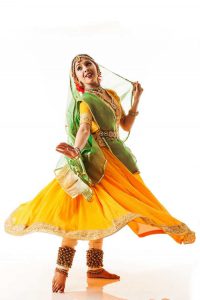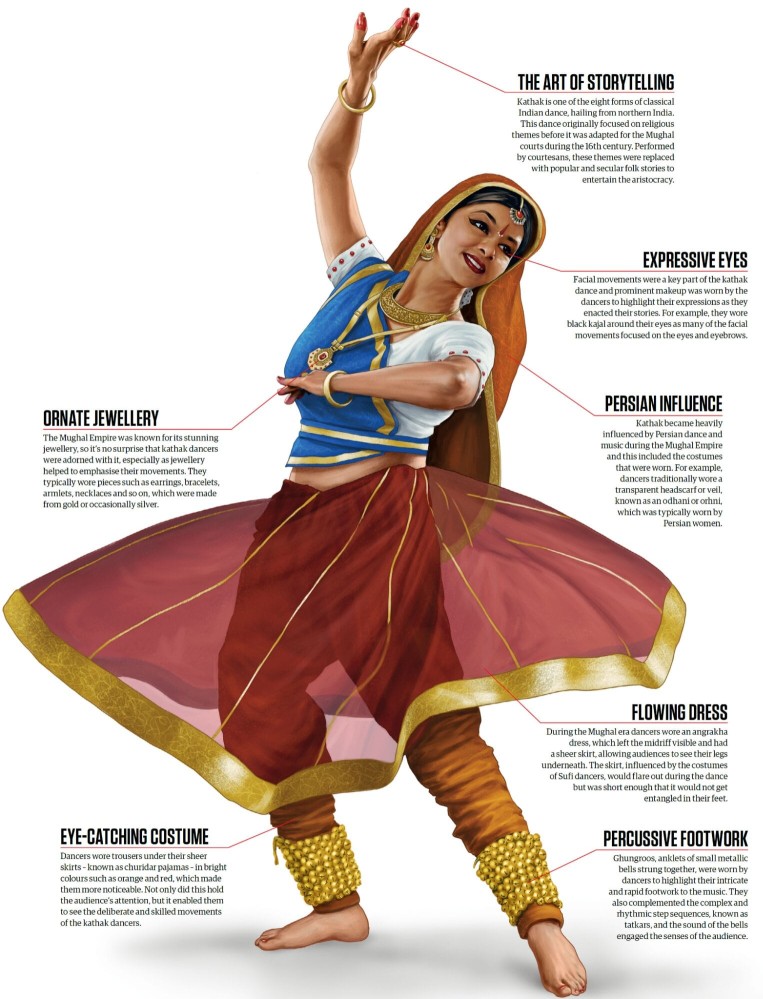Kathak is a classical dance form originating in North India, known for its storytelling through intricate footwork, spins, and rhythmic patterns, often accompanied by music and ankle bells.
Origin and Evolution
-
“Katha” meaning “story”:
The word “Kathak” comes from the Sanskrit word “Katha,” meaning “story,” reflecting the dance’s core function of storytelling.
-
Oral Tradition:
Kathak evolved as an oral tradition, passed down through generations of teachers and disciples (Guru-Shishya Parampara).
-
Hindu and Muslim influences:
Kathak developed under the influence of both Hindu and Muslim cultures, making it a unique synthesis of artistic traditions.
-
Storytelling through dance:
Kathak dancers, or kathakars, tell stories based on epics, myths, and legends, using a combination of dance, music, and vocalization.
-
From temples to courts:
Kathak originated in Hindu temples as a storytelling device, but it later became a part of court culture, performed under the patronage of Persian and Mughal rulers.
-
Intricate footwork:
Kathak is known for its intricate and precise footwork, with dancers controlling about 100 ankle bells to create rhythmic patterns.
-
Upright posture and spins:
The dance is characterized by an upright posture, eclectic spins, and a technical repertoire.
-
Abhinaya (expression):
Kathak dancers use a range of facial expressions and gestures to convey emotions and stories.
-
Hindustani music:
Kathak is closely tied to Hindustani or North Indian music, which enhances the storytelling and rhythmic elements of the dance.
-
Instruments:
Common instruments accompanying Kathak performances include tabla, harmonium, sarangi, and manjira.
-
Lucknow, Jaipur, and Banaras:The three major schools of Kathak are Lucknow, Jaipur, and Banaras, each with its own distinct style and characteristics.
-
Lucknow Gharana:Known for its graceful and lyrical style, often associated with the Kathak maestro Pandit Birju Maharaj.
-
Jaipur Gharana:Characterized by its fast-paced and acrobatic movements, with a focus on rhythmic precision.
-
Gharanas:
Kathak has three main schools or styles (Gharanas): Lucknow, Jaipur, and Banaras.
-
Patronage:
Kathak became an established part of court culture, performed under the patronage of India’s Persian kings and Muslim mughals
-
Modern Significance:
Today, Kathak is a recognized Indian classical dance form, enjoyed both locally and globally.
-
National Institute of Kathak Dance:The National Institute of Kathak Dance, also known as Kathak Kendra, is a premier dance institution dedicated to Kathak, situated in New Delhi.BASICS OF KATHAK ???FUNDAMENTAL TECHNIQUES
- Tatkaar is a rhythm-bound footwork. …
- Chakkar – In Kathak, the dancers spin on their feet. …
- Abhinay – Out of the three fundamental skills of Kathak, abhinaya is the aspect that breathes life into the dance.
- Tandava – A dance expression that takes after the tandava nritya of Lord Shiva.
History and Evolution
The foundations of Kathak are rooted in Natya Shastra, an ancient Sanskrit text written by Bharata Muni.
Collection
The three chief sections of a Kathak dance are:
Invocation: where the artist offers his/her prayer or salutation to his/her guru and to god. In the case of Hindu performances, the artist uses mudras (hand gestures) for the same. For Muslim occasions, the artist gives a ‘salami’.
Nritta: pure dance portrayed by the artist. He/she starts with slow and graceful movements of the neck, wrists and eyebrows. This is followed by fast sequences according to ‘bols’. A bol is a short sequence of rhythmic pattern. Here the artist displays energetic footwork also.
Nritya: here the artist showcases a story or theme through gestures, expressions and slow body movements accompanied by vocal and instrumental music.
As Kathak is prevalent both in Hindu and Muslim people group the outfits of this moving frame are made in accordance with customs of the separate groups.
Read about classical dance forms of India in the linked articles below:
- Bharatnatyam
- Kuchipudi
- Odissi
- Manipuri
- Kathakali
- Mohiniyattam
- Sattriya
Instruments and Music
A Kathak execution may incorporate twelve traditional instruments depending more on the impact and profundity required for a specific execution. However, a few instruments are commonly utilized as a part of a Kathak execution like the tabla that blends well with the musical foot developments of the artist and regularly emulates the sound of such footwork developments or the other way around to make a splendid jugalbandi. A manjira that is hand cymbals and sarangi or harmonium are additionally utilized frequently.

-

Pingback: HOW KATHAK IS DIFFERENT FORM - kathakwithus.com